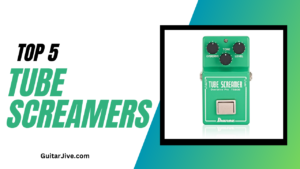Introduction
Have you ever wanted to have a tremolo effects pedal as part of your guitar rig but don’t know where to start? Are you confused about the difference between vibrato and tremolo? Do you wonder how these effects work or what types are there? Do you want to place a tremolo pedal on your pedalboard? If so then read on.

1. Tremolo Is Not Vibrato
The first step is understanding that tremolo is not the same as vibrato. These two terms often get confused. The matter is not helped by certain guitar manufacturers who put “tremolo arms” on their guitars. These should be called “vibrato arms” as that is the effect they are producing.
Tremolo is a variance in the waveform volume. Whereas vibrato is a variance in the waveform pitch. The arm on your guitar strains the strings resulting in a higher pitch, which when released lowers the pitch. The volume remains constant.

2. How Do Tremolo Pedals Work?
Tremolo is the rapid variation of volume in a musical instrument. It is a technique that has been used since the Baroque period. So it is not something new, however, these days the only thing you need to do is activate your effects pedal. The tremolo pedal is an effect that can be applied to electric guitars or bass guitars. The tremolo pedal creates these rhythmic pulses by rapidly turning the volume up and down, which makes a “wavy” sound.
Tremolo is a type of amplitude modulation (AM) where the amplitude of the sound varies in a periodic fashion. This is usually created by mixing your guitar signal with a generated carrier signal from a Low-Frequency Oscillator (LFO). The carrier signal varies in amplitude, the limits of which are set by both your playing and the effects pedal controls. The upper limit is determined by how loud or hard you pluck the strings and the lower limit is set by the “depth” control.
3. What Are The Different Types Of Tremolo Pedals?
Tremolo used to be an effect that was produced by your amplifier, in fact, I still have an amplifier with a tremolo circuit in it. These days though there’s a huge range of tremolo pedals out there. But there are some different types that you need to be aware of.
Triangle Wave Tremolo
This is probably the most popular and most useable tremolo-type circuit out there. As the name suggests a triangle wave is used, this gives the benefit of the waveform and the effect produced being linear in nature, meaning the ups and downs are the same and occur at regular intervals. This is the type that can be found in the hugely popular Boss TR-2 Tremolo, I recommend giving this type of tremolo effect a try.
Square Wave Tremolo
You’ve probably guessed it by the name, this type uses a square wave, and it has the effect of turning the signal on and off. I particularly like this type as in my eyes guitar effects need to be kind of fun. These can be used to good effect when used in the mix with other guitars.
Sine Wave Tremolo
This is a traditional type of tremolo that can be found on many amplifiers. As a sine wave is rounded in comparison to the triangle and square waves, the transitions between the highs and lows are more gradual and result in a smoother sound, the dis benefit here though is that it may not cut through as well as a triangle wave.
4. Tremolo Pedal Settings
So you’ve got your tremolo pedal, but how do you set it up so that you can get it working for you? To cover every knob on every tremolo pedal, would be almost impossible, so I’m not even going to try. However, there are 2 knobs that are common to most tremolo pedals, which are a good idea to understand. They are “Speed” and “Depth”:
Speed
The “Speed” control adjusts the frequency of the carrier wave, or how fast the cycles of volume variation occur. The important thing here is that you need to set the speed to the tempo of the song that you are playing. Imagine how bad it sounds when your band is playing in sync and you’re playing at a different tempo, it stands out like a sore thumb. Therefore it is not only your playing that needs to be in sync but also your tremolo pedal.
You can adjust this whilst your band or record is playing. Some tremolo pedals may come with a “tap tempo” function, which makes this a bit easier as you just tap the button to the tempo of the song to lock it in.
Depth

5. Tremolo Pedal Placement Order
The next step is knowing where to place your tremolo pedal amongst your pedal chain. You want your tremolo pedal to go after all of your drive pedals, such as boost, Overdrive & Distortion, etc. It needs to be grouped with your other modulation effects, I would suggest putting it after the other modulation effects such as chorus and Flanger.
The next pedals after your tremolo should be reverb or delay, this way the whole of your dry signal chain is being affected by the tremolo before any reverb or delay is added. You can experiment with putting it after your reverb pedal but you may find that it’s not to your taste.
If you’re using the drive channels on your amp, another option could be to put the tremolo pedal in the effects loop, by making use of the “effects send” and “effects return” on your amplifier. Here you’ll be applying the tremolo effect to the signal after the pre-amp stage but before the final amplification. The benefit of this is that it will do away with the wet and muddled sound you may experience when putting the tremolo pedal in front of your amp and prior to the distortion.
Conclusion
Hopefully, you have a better understanding of tremolo and tremolo pedals now. The subject can be quite complex, not helped by the confusion with vibrato. The tremolo pedal is one of the first guitar effect pedals most people will buy. And while they may seem difficult to use at first, they are very easy to master once you understand how they work. These five steps will take you through everything you need to know to produce your own signature tremolo sound. Feel free to post comments below, follow GuitarJive.com on Social Media, and be sure to check out my other effects pedal posts.




Pingback: A Beginner’s Guide to Guitar effects pedals. | Guitar Jive
Pingback: The Great Distortion Vs Overdrive Debate: What Is The Difference?
Pingback: What Is Fuzz? The Ultimate Explanation Of Fuzz Effects Pedals
Pingback: What Is Flanger? Why You Need a Flanger Effects Pedal! |
Pingback: Pedalboard Signal Chain: A Simple (But Complete) Guide
Pingback: What Is a Multi-Effects Pedal? you need to try one! | Guitar Jive